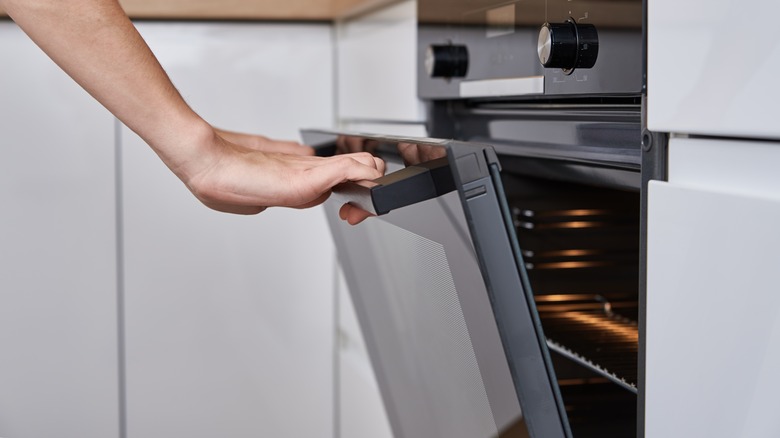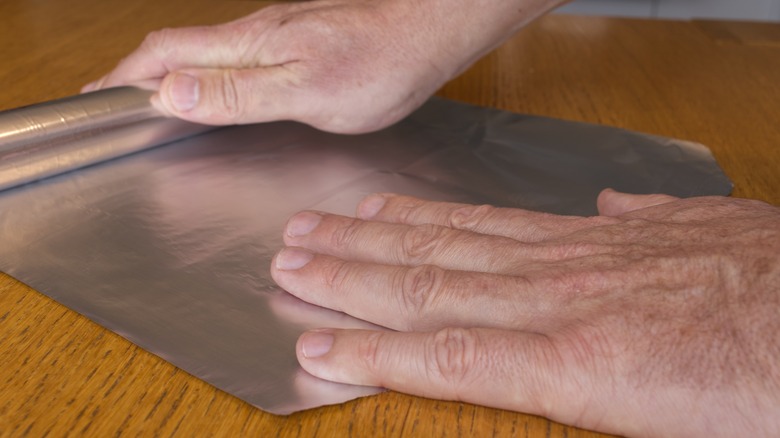Why You Shouldn't Place Aluminum Foil On The Bottom Of Your Oven
Lining the bottom of your oven with aluminum foil appears, at first glance, to be a simple and effective solution to one of cooking's most tiresome tasks: cleaning the oven. The foil conveniently catches all those pesky spills, drips, and bits of food that used to burn onto the oven floor. No more scrubbing, no more harsh cleaning chemicals. Sounds like a great hack, right? But this method has drawbacks, just like many other things that seem too good to be true.
Although it seems harmless, it can result in significant problems, some of which might permanently harm your cherished kitchen item. When you lay a sheet of aluminum foil on the bottom of your oven, you inadvertently introduce a new element and change the precisely designed heat dynamics of the appliance. The primary problems arise from how aluminum foil interacts with the heat produced by the oven, causing unintended and undesirable side effects.
Given these potential complications and risks, it's clear that this kitchen hack isn't as helpful as it first appears. Let's unpack the various reasons to rethink this seemingly convenient practice. We'll also explore safer, more effective alternatives to maintain the cleanliness of your oven — all in the interest of saving you time, money, and the life of your beloved appliance.
Possible damage to your oven
The first and most obvious reason you shouldn't line the bottom of your oven with aluminum foil is the potential damage it could cause. Many ovens have sensitive heat distribution systems that help ensure it circulates evenly and cooks your food uniformly. When you line the bottom with aluminum foil, you're interfering with the oven's ability to distribute heat evenly.
The foil acts as a barrier, blocking the heat and reflecting it onto the oven. This might seem like a good way to make it more efficient, but the reality is quite the contrary. The concentrated heat could damage the oven's heating elements or even the oven's interior lining. Over time, this could cause the appliance to break down, leading to costly repairs or replacements.
Beyond the physical damage, aluminum foil in your oven may create serious performance issues. The reflected heat might lead to hot spots, resulting in uneven cooking. Primarily, this stems from the foil's capacity to reflect heat — the heat that's supposed to be evenly distributed throughout the oven cavity gets reflected, concentrating in certain areas.
These hot spots disrupt the even temperature field within your oven, leading to inconsistent cooking results. Your cookies could be burned on one side and undercooked on the other, which certainly isn't what you want after spending hours in the kitchen.
Safety hazards posed by aluminum foil
Another common concern with aluminum foil is the possibility of causing scratches on your oven's enamel surfaces. The interior of your oven is often lined with a hard, glossy coating known as enamel. It's durable and heat resistant, making it ideal for the high-heat environment inside the oven. However, when you remove or adjust the aluminum foil, it comes into contact with these surfaces, potentially leading to unsightly scratching, which you'll probably notice when cleaning your oven.
Scratches detract from the aesthetic appeal of your oven's interior and compromise its functionality. The scratches on the enamel can become points of weakness where further damage could occur over time. This may lead to chipping and more extensive enamel loss, which could affect the efficiency and lifespan of your oven in turn.
Moreover, an additional risk comes from the aluminum foil's potential to melt when in contact with hot surfaces or elements. Certain areas of the oven, particularly near the heating elements, can become extraordinarily hot. If aluminum foil comes into contact with these intensely hot areas, it can melt and adhere to the oven's surfaces or elements.
If you're looking for safer and more effective alternatives than aluminum foil, oven-safe silicone baking mats are a good choice. They are non-stick and eliminate the need for parchment paper or greasing. More importantly, they are easy to clean, significantly simplifying post-baking cleanup. These qualities make silicone baking mats an environmentally friendly, cost-effective, and convenient choice for every baking enthusiast.

